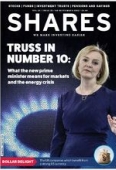Archived article
Please note that tax, investment, pension and ISA rules can change and the information and any views contained in this article may now be inaccurate.
Bond and currency markets will be first test for new UK Prime Minister Liz Truss

The stock market may well have its say on Liz Truss’ first new policy initiatives as prime minister, but the response of the government bond – or gilt – market and the pound may be more telling, at least in the very short term.
Financial markets express their faith – or lack of it – in a country and its economic and political prospects through how much they charge it to borrow and how they value its currency. In each case traders and investors seem to be already turning away, presumably because they do not like what they see.
If the new prime minister can put an end to the sell-off in both the UK government bond market and sterling that would be a major coup, although the odds seem to be stacked against Truss, as she must immediately juggle inflation at a 40-year high, the threat of a recession, an energy crisis, war in Ukraine, the weak pound, rising interest rates and the Government’s own state of penury.
STERLING SLIDE
Sterling continues to lose ground against the dollar, and it is trading below $1.1500 for the first time since 1985. Technical analysts – or chartists – may be tempted to argue that if $1.1500 really gives way then a drop to $1.0500 is on the cards, the low seen in spring 1985.
That was the year when the G5, as they were then, struck the Plaza Accord to rein in a rampant dollar and right now the dollar is strong across the board once more. As such, you can try to argue that the dollar is not a fair benchmark for sterling, except the pound is stumbling against the energy-crisis-hit euro, too.
At €1.1573, the pound is back to where it was against the single currency in summer 2021, despite the EU’s own deep energy and economic woes.
A weak pound can help exports, but it also increases import costs and that is not ideal at a time when inflation is already galloping higher.
BOND MARKET BLITZ
Sterling may be sliding but Government borrowing costs are soaring. This suggests the bond market does not think too much of what it sees in the UK, either – although the Bank of England’s interest rate rises in its belated battle to rein inflation back in has a big role to play here, too.
While still low by historic standards, the yield on the benchmark UK government bond, or gilt, is a full percentage point higher than a year ago. At 2.92%, the 10-year gilt yield is within touching distance of 3.00% for the first time since early 2014.
This is in recognition of the surge in inflation, and the Bank of England’s shift to raising interest rates and toward quantitative tightening. That adds to the Government’s interest bill on its £2.4 trillion debt and potentially limits scope for spending or tax cuts.
Worse still, the yield curve is now inverted. Normally, the yield on the 10-year gilt is higher than that of the two-year paper, as bondholders demand a higher return to compensate themselves for the greater risk represented by the longer holding period. That additional time means there is more scope for things going wrong.
From a bond investor’s point of view that usually means inflation, interest rate increases or – in a worst case – default where the borrower is unable to pay the coupons or return the original investment in full once the bond matures.
In August, however, the yield on the two-year gilt moved up faster than that of the 10-year, with the result that the shorter-term paper offers a higher yield.
This is usually a sign that the bond market is pricing in a recession, as it anticipates future interest rate cuts, and thus a drop in borrowing costs.
It is by no means a flawless indicator, but the UK yield curve inverted ahead of the 1991-92 downturn and the deeper 2007-09 recession. While the inversions of 1998 and 2000 proved false signals, they did reflect concerns over the potential for the stock market’s bust in technology, media and telecoms stocks to spill into, and weigh on, the real economy.
CURVE CALAMITY
Stock market investors, as well as bondholders and currency traders, will be watching the yield curve very closely. It does not invert often, at least if the last 30 years are any guide, but it can be a warning of trouble ahead for holders of UK equities.
The FTSE All-Share dipped briefly into a bear market in 1989-90, wobbled in 1998 thanks to the Asian and Russian debt crises, plunged in 2000-2003 as the tech bubble burst, collapsed in 2007-09 as the Great Financial Crisis struck. On each occasion the yield curve had inverted, although the indicator did briefly give a false signal in August 2019.

Truss may find herself potentially trapped between inflation on one side and recession on the other. If the financial markets like what they hear then gilt yields might be held in check, the yield curve steepens and the pound rallies. If not, then the yield curve continues to invert, and sterling may keep sliding.
Important information:
These articles are provided by Shares magazine which is published by AJ Bell Media, a part of AJ Bell. Shares is not written by AJ Bell.
Shares is provided for your general information and use and is not a personal recommendation to invest. It is not intended to be relied upon by you in making or not making any investment decisions. The investments referred to in these articles will not be suitable for all investors. If in doubt please seek appropriate independent financial advice.
Investors acting on the information in these articles do so at their own risk and AJ Bell Media and its staff do not accept liability for losses suffered by investors as a result of their investment decisions.
Issue contents
Ask Tom
Feature
Great Ideas
News
- Vistry fires starting gun on housebuilder M&A with £1.2 billion bid for Countryside
- UK investors pull a record £1.93 billion out of stock-based funds
- What new prime minister Liz Truss means for markets and energy prices
- ASOS shares slump as a briefing bombshell spooks the market
- Why China-focused Welkin offers investors something new as it plots $300 million float
 magazine
magazine








